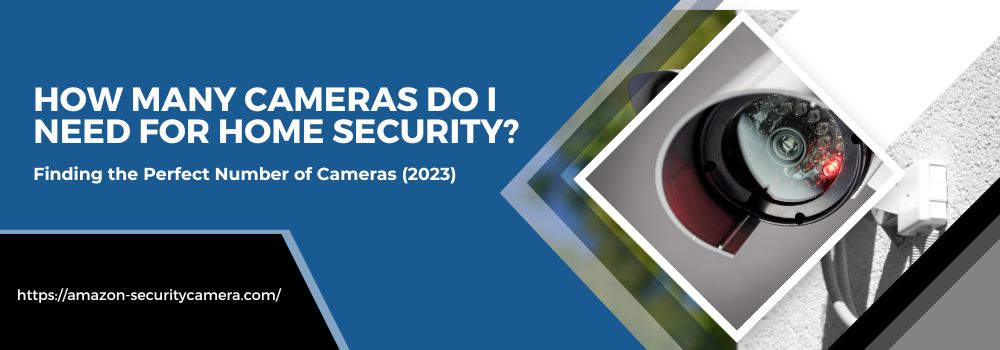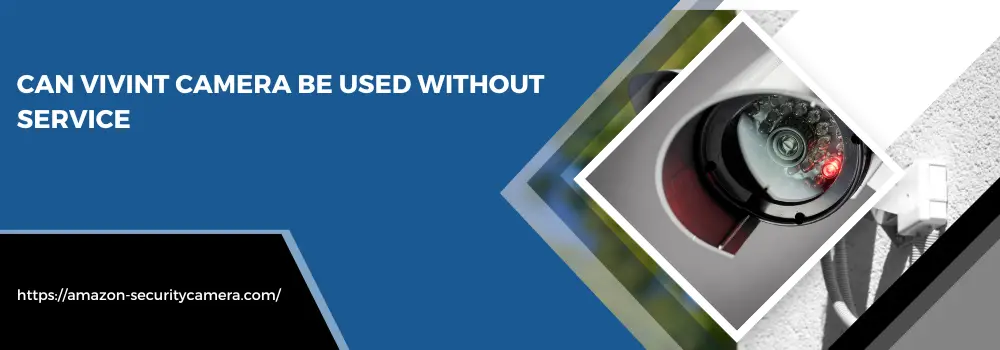It’s no secret that one of the best ways to keep your home and family secure is with a quality home security system.How many cameras do I need for home security? But if you are considering adding cameras for extra surveillance around your property, you naturally ask yourself: just how many cameras do I need?
Well, pop on your detective hat because there isn’t a one-size-fits-all answer to this! The number of cameras you need for home security is like guessing how many jelly beans are in a jar at the county fair. It depends on a variety of factors such as the size of your home, the layout, and the areas you want to cover. A small apartment might just need a single camera, while a sprawling mansion might need a dozen or more. It’s all about crafting your personal, cozy blanket of surveillance!
But fear not! If you’re worried about figuring out the perfect amount of cameras for best coverage and protection in 2023, we have all the answers here. Read on to discover exactly what to look for when shopping for security cameras both indoors and outdoors.
Table of Contents
Understanding the Basics of Home Security Cameras
Home security cameras come in various types, including bullet, dome, PTZ, or hidden. Each type has its unique features, strengths, and weaknesses. Understanding their differences is crucial in determining the number of cameras needed. Your choice should consider the camera’s field of view, resolution, connectivity, and power source.
- Field of View (FoV): The field of view refers to the width of the area a camera can capture. Cameras with a wider FoV can monitor large spaces with a single device, reducing the number of cameras needed. In contrast, cameras with a narrower FoV are better suited for monitoring targeted areas like doorways or windows.
- Camera Resolution: The resolution of a camera determines the clarity and detail of the recorded footage. Higher-resolution cameras provide clearer images, which are beneficial when you need to identify faces or license plate numbers. However, they also require more storage space and bandwidth.
- Connectivity: Modern security cameras can connect to the internet, allowing for remote monitoring and control. Wired cameras provide a stable connection but require professional installation, while wireless cameras offer more flexibility in positioning but may suffer from interference.
- Power Source: Security cameras can either be powered by electricity or batteries. Wired power sources are reliable but limit where you can install the camera. Battery-powered cameras offer more flexibility but require regular maintenance to ensure they remain operational.
- Camera Type: There are several types of security cameras – bullet, dome, PTZ (Pan-Tilt-Zoom), and hidden. Bullet and dome cameras are common for outdoor use due to their durability, while PTZ cameras offer the benefit of manual or automatic adjustment of the field of view. Hidden cameras, on the other hand, are ideal for discreet monitoring indoors.
Identifying Your Security Needs
Identifying your security needs is the first crucial step in determining how many cameras you’ll need for home security. It involves understanding what you want to protect and the areas of your property that require surveillance.
- Perimeter Assessment: Walk around your property to identify potential entry points like doors or windows. These areas typically require surveillance.
- Property Size: The larger your property, the more cameras you may need. Consider the size and layout of your property when deciding on the number of cameras.
- Indoor vs. Outdoor: Determine if you want surveillance inside your home, outside, or both. Outdoor cameras tend to deter potential intruders, while indoor cameras can capture events if an intruder gets inside.
- Valuable Areas: Identify areas inside your home with valuables, like the living room or study. These rooms might necessitate dedicated surveillance.
- Visibility: Cameras placed in visible locations can act as deterrents to potential intruders. Consider having at least some cameras clearly visible.
- Storage and Bandwidth: Higher-resolution cameras and a larger number of cameras will require more storage space and internet bandwidth.
- Budget: Your budget will also influence the number of cameras you can afford. Consider the cost of the cameras themselves, as well as installation and ongoing maintenance costs.
The Benefits of Multiple Camera Systems
Multiple camera systems offer a comprehensive security solution, providing extensive coverage and a high degree of flexibility and control. These systems come with numerous benefits that can significantly enhance your home security strategy.
- Comprehensive Coverage: Multiple cameras provide a wide coverage area, capturing activities around your entire property.
- Deterrence: Visible cameras can deter potential intruders, reducing the risk of break-ins.
- Evidence Gathering: In case of a security breach, multiple cameras increase the likelihood of capturing useful evidence.
- Remote Monitoring: Many systems allow remote viewing of camera feeds, enhancing control over your property.
- Alerts: Advanced systems can send alerts when suspicious activity is detected.
- Flexibility: Multiple camera systems allow placement at various locations based on security needs.
- Resolution Options: You can opt for higher-resolution cameras in critical areas for better image clarity.
- Night Vision: Many multiple-camera systems come with night vision capabilities for round-the-clock security.
- Cost-Effective: In the long run, investing in a multiple-camera system can be more cost-effective than single-camera solutions.
- Peace of Mind: The enhanced security offered by multiple cameras provides a sense of safety and peace of mind.
Calculating the Optimal Number of Cameras for Maximum Coverage
Calculating the optimal number of cameras for maximum coverage involves assessing your property’s unique layout and potential vulnerability points. Consider the following factors:
- Property Size: Larger properties may require more cameras for comprehensive coverage.
- Entry Points: Doors and windows are common entry points for intruders and should be monitored.
- High-Risk Areas: Isolated areas, such as garages or basements, may need additional surveillance.
- Indoor vs. Outdoor: Balance your security system between both indoor and outdoor coverage.
- Visibility: Ensure cameras are placed in locations with unobstructed views for best results.
Choosing the Right Type of Home Security Camera System
Selecting the right type of home security camera system is crucial in ensuring optimal protection. Your choice should align with your property’s specific needs, your lifestyle, and your budget.
- Wireless vs. Wired: Wireless cameras offer easy installation and flexibility, while wired cameras provide a more stable and interference-free transmission.
- Analog vs. Digital: Analog cameras are cost-effective but offer lower-quality images; digital cameras provide high-resolution footage but are more expensive.
- Indoor vs. Outdoor Cameras: Indoor cameras often have more features since they’re not subject to weather conditions. Outdoor cameras need to be sturdy and weather-resistant.
- Dome vs. Bullet Cameras: Dome cameras are more discreet and vandal-resistant, while bullet cameras provide a longer range of view.
- Monitored vs. Unmonitored Systems: Monitored systems provide 24/7 surveillance by a security company, while unmonitored systems rely on you or your neighbors to alert the authorities.
- Camera Resolution: Higher resolution cameras offer sharper images but require more storage space.
- Integrated Systems: Some cameras integrate with smart home systems, allowing remote control and automation.
Tips on Installing and Maintaining Your Home Security System
Installing and maintaining your home security system is a crucial step in maximizing its effectiveness and longevity. Here are some important considerations:
- Location: Install cameras at strategic points, like entrances or windows.
- Height: Position cameras at an optimal height to deter tampering and ensure a clear view.
- Lighting: Ensure adequate lighting for clear footage, especially for night vision cameras.
- Maintenance: Regularly clean cameras and check for lens obstructions.
- Power Backup: Consider backup power options to keep the system running during power outages.
- Software Update: Keep your system’s software updated for optimal performance and security.
- Storage: Regularly check and manage storage space to ensure continuous recording.
- System Test: Periodically test the entire system to identify and address issues promptly.
- User Training: Ensure all household members are familiar with operating the system.
- Professional Help: Consider professional help for technical issues and annual maintenance checks.
Conclusion
In conclusion, the number of cameras required for home security varies on factors such as the size of the property, key areas to be monitored, and personal security needs. A well-installed and maintained security system significantly enhances the safety of your home.
Remember, it’s not just about the number of cameras, but also their strategic positioning, resolution, and integration capabilities. Regular maintenance and user training are equally important for optimal functionality. Make your home a safe haven – prioritize its security today.
Faqs
Q1. How many ring cameras do I need for my house?
A1. The number of Ring cameras you need for your house depends on various factors such as the size of your property, the number of entrances, and the specific areas you wish to monitor. For an average-sized home, you might start with 3-4 Ring cameras: one for the front door, and back door, and a couple to cover interior spaces or other outdoor areas. However, for larger properties or homes with multiple entry points, you might need more. Always consider your unique security needs and consult with a professional if in doubt.
Q2. How many CCTV cameras can I have in my house?
A2. The number of CCTV cameras you can have in your house is not strictly limited, but it depends on various factors such as the size of your property, the number of entrances, and your specific security needs. Typically, for an average-sized home, about 4-6 cameras might be sufficient: one for the front door, one for the back door, and the rest to cover interior spaces or other vulnerable areas. However, larger properties or homes with multiple potential entry points might require more. It’s always advisable to assess your particular security requirements and consult with a professional to determine the optimal number of CCTV cameras for your home.
Q3. How many security cameras do I need on Reddit?
A3. The number of security cameras you need can vary greatly depending on your specific circumstances and the layout of your home. Reddit users often suggest starting with 3-4 cameras for an average-sized home, usually placed at key points such as entrances and main traffic areas. However, for larger homes or properties with multiple entry points, more may be necessary. User experiences and advice can greatly differ, so it is encouraged to assess your own situation, possibly consult with a security professional, and consider options beyond just the number of cameras, such as the type of camera and its capabilities.



